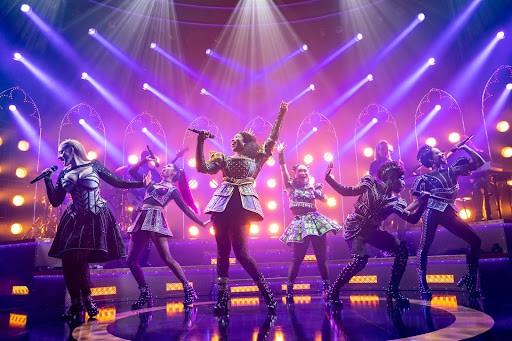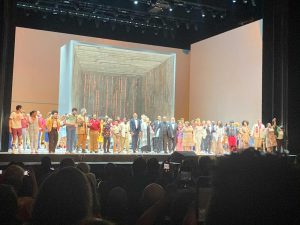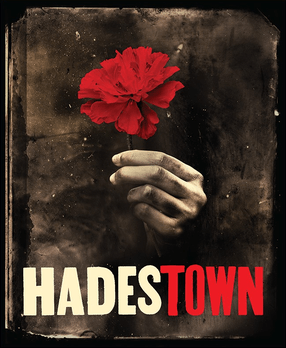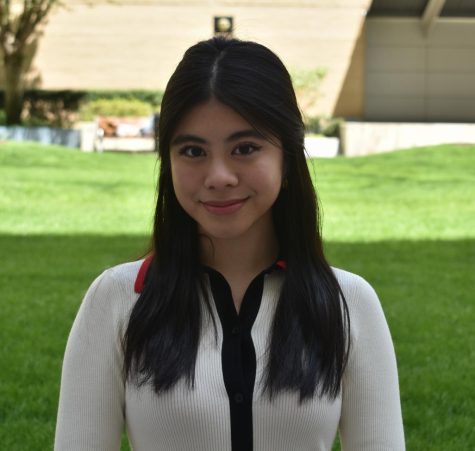‘Six’: Breaking Broadway Conventions Since the 16th Century
In a joyous celebration of femininity and individuality, history isn’t the only thing overthrown

COURTESY OF ANGELA YAMARONE
‘Six’ sees all six wives of the infamous Henry VIII transformed into a modern-day girl band.
November 8, 2021
Audience members filed into the Brooks Atkinson Theatre with expectations as high as its gilded ceiling, knowing full well that “Six” has a reputation to live up to even before the lights dim and the curtain rises.
This is due largely in part to the musical’s widespread online success — its internet presence was indisputable even before making a home on Broadway, as evidenced by its songs going viral on TikTok and as backings to many YouTube animations. The musical’s influence, especially on younger fans, is only reaffirmed by the wall of fanart seen upon entering the venue and the audience members in line wearing homemade costumes and makeshift crowns.
Such a stature only increases the expectations of American audiences, who eagerly anticipate all the passion and pizzazz promised by its soundtrack and recordings of West End shows. “Six,” a Broadway musical, doesn’t falter. What audiences are treated to is an experience that fully exceeds these expectations.
The story takes King Henry VIII’s lust and libido and rewrites it into an empowering, unapologetically female take on a fragment of history that is usually told from the man’s perspective.
Packed into 80 minutes — with no intermission — “Six” is a musical journey into 16th-century Tudor England delivered with all the flair of a 21st-century pop group. The story takes King Henry VIII’s lust and libido and rewrites it into an empowering, unapologetically female take on a fragment of history that is usually told from the man’s perspective.
The musical itself is modeled after a concert, and in order to achieve this feel, the characters begin the show by constantly breaking the fourth wall. Or, perhaps it’s not appropriate to say the fourth wall had been broken if it was never present in the first place: The actors greet the audience just before the opening number similar to how a band performing at Madison Square Garden would.
Audience participation is one of the play’s defining qualities, and audience members should be prepared to come in with energy for the cast to play off of. As one of the earliest shows to reopen on Broadway after the COVID-19 pandemic, the actors seem just as thrilled to be back as the audience does, and their excitement is almost palpable.
The all-female cast and musical ensemble, fondly referred to as “queens” and “ladies-in-waiting,” are composed of only 10 members total — which is just one example of the many ways that “Six” actively breaks Broadway conventions. Despite the small cast size, there is no weak link, as each actress imbues her solo with a unique energy that’s distinct from the performance before and after.
The leading ladies’ vocals and chemistry are so central to the show’s success that the musical doesn’t have to resort to gimmicks or stage tricks to leave a lasting imprint on viewers. The presence of an on-stage band creates a concert-like feel, whereas the backing musicians are people you can put a face to. Such a set-up recognizes the ensemble as playing a role equally as important as the principal cast.
However, the show sometimes finds itself running into an issue that historical musical adaptations often fall victim to: attempting to cram too much factual information into the songs so that it sounds like a history lecture. The musical is also modeled in such a way that each queen takes inspiration from a female pop icon. Jane Seymour, played by Abby Mueller, and her soulful ballad, for instance, are reminiscent of Adele). While the show has a wide range of musical variety, the consequences of this are jarring shifts in the play’s overall tone as it oscillates wildly from genre to genre and noticeable dips in energy when progressing from faster-paced songs to slower ones.
While history remains unchangeable and the real queens’ fates have been long since sealed, the ability to rewrite their own story is always an option.
Arguably some of the show’s most standout features are the costumes and set design, which accentuate the magic of this 16th-century fever dream while not detracting attention from the cast themselves. The outfits are a marriage between traditional Tudor sleeves and blackwork bodices and the swishy petticoated skirts and neon colors of modern-day superstars. This unlikely combination — so unabashedly gaudy that it’s good — enables the cast to look the part of a female pop group while also paying homage to Renaissance fashions. The set design is minimal, but it sells the concert vibe further with handheld microphones and strobe lights that stretch far into the orchestra and mezzanine.
The applause from both the audience and the cast echoed throughout the Brooks Atkinson Theatre, welcoming everyone back to Broadway. There weren’t any dirty looks shared if someone clapped too loudly or sang along. In fact, that kind of behavior — belonging more to stadiums than playhouses — was actively encouraged. Fans are invited to get up from their seats and dance to the finale, which acknowledged that while history remains unchangeable and the real queens’ fates have been long since sealed, the ability to rewrite their own story is always an option.
“Six” shouldn’t be written off as just one of the plays riding the post-“Hamilton” wave of historical musical adaptations. Rather, it is a show that takes the standard theater conventions and turns them on their heads. There is no better way to signal that Broadway is back than with the fresh vitality that “Six” brings to the stage.













